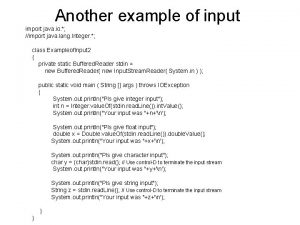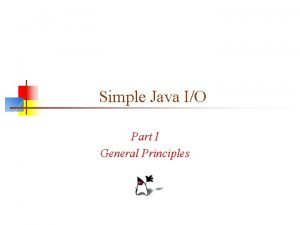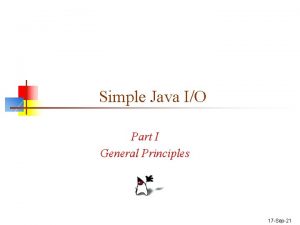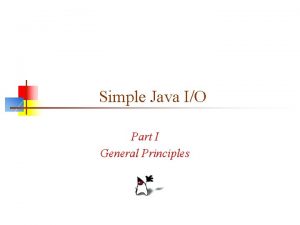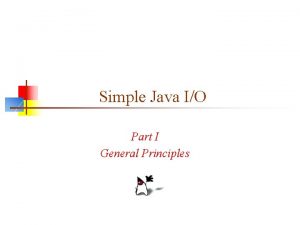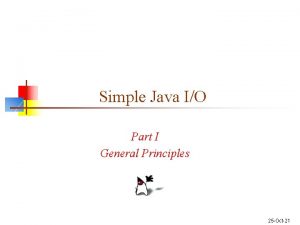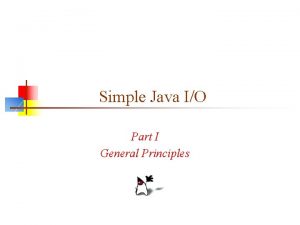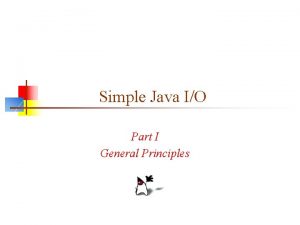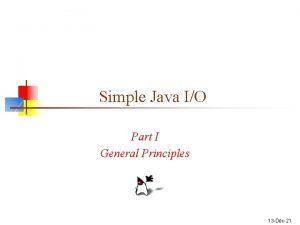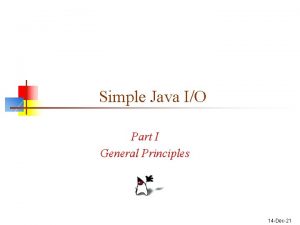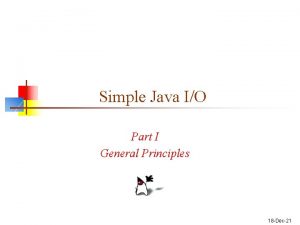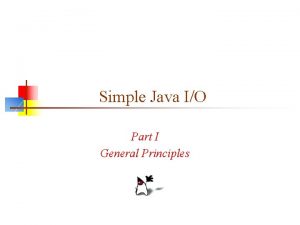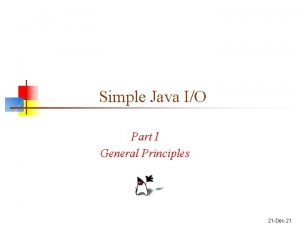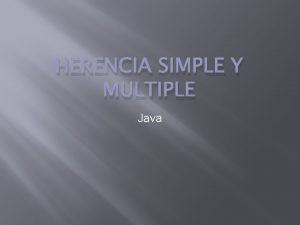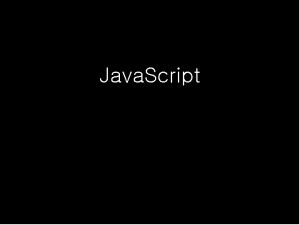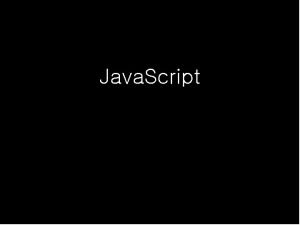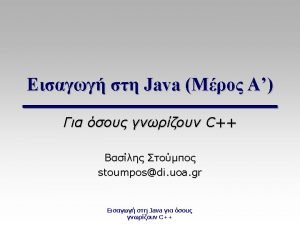Simple Java IO Part I General Principles 27


























- Slides: 26

Simple Java I/O Part I General Principles 27 -Oct-21

Prologue “They say you can hold seven plus or minus two pieces of information in your mind. I can’t remember how to open files in Java. I’ve written chapters on it. I’ve done it a bunch of times, but it’s too many steps. And when I actually analyze it, I realize these are just silly design decisions that they made. Even if they insisted on using the Decorator pattern in java. io, they should have had a convenience constructor for opening files simply. Because we open files all the time, but nobody can remember how. It is too much information to hold in your mind. ” —Bruce Eckel, http: //www. artima. com/intv/aboutme 2. html 2

Streams n n n All modern I/O is stream-based A stream is a connection to a source of data or to a destination for data (sometimes both) An input stream may be associated with the keyboard An input stream or an output stream may be associated with a file Different streams have different characteristics: n n A file has a definite length, and therefore an end Keyboard input has no specific end 3

How to do I/O import java. io. *; n n n Open the stream Use the stream (read, write, or both) Close the stream 4

Why Java I/O is hard n n n open use close Java I/O is very powerful, with an overwhelming number of options Any given kind of I/O is not particularly difficult The trick is to find your way through the maze of possibilities 5

Opening a stream n n n open use close There is data external to your program that you want to get, or you want to put data somewhere outside your program When you open a stream, you are making a connection to that external place Once the connection is made, you forget about the external place and just use the stream 6

Example of opening a stream n open use close A File. Reader is a used to connect to a file that will be used for input: File. Reader file. Reader = new File. Reader(file. Name); n n The file. Name specifies where the (external) file is to be found You never use file. Name again; instead, you use file. Reader 7

Using a stream n n n open use close Some streams can be used only for input, others only for output, still others for both Using a stream means doing input from it or output to it But it’s not usually that simple--you need to manipulate the data in some way as it comes in or goes out 8

Example of using a stream open use close int char. As. Int; char. As. Int = file. Reader. read( ); n n The file. Reader. read() method reads one character and returns it as an integer, or -1 if there are no more characters to read The meaning of the integer depends on the file encoding (ASCII, Unicode, other) You can cast from int to char: char ch = (char)file. Reader. read( ); File. Reader. Example 1. java 9

Manipulating the input data n n n open use close Reading characters as integers isn’t usually what you want to do A Buffered. Reader will convert integers to characters; it can also read whole lines The constructor for Buffered. Reader takes a File. Reader parameter: Buffered. Reader buffered. Reader = new Buffered. Reader(file. Reader); 10

Reading lines open use close String s; s = buffered. Reader. read. Line( ); n n A Buffered. Reader will return null if there is nothing more to read File. Reader. Example 2. java 11

Closing n n n open use close A stream is an expensive resource There is a limit on the number of streams that you can have open at one time You should not have more than one stream open on the same file You must close a stream before you can open it again Always close your streams! Java will normally close your streams for you when your program ends, but it isn’t good style to depend on this 12

Simple Java I/O Part II Line. Reader and Line. Writer 27 -Oct-21

Text files n Text (. txt) files are the simplest kind of files n n Text files can be used by many different programs Formatted text files (such as. doc files) also contain binary formatting information Only programs that “know the secret code” can make sense of formatted text files Compilers, in general, work only with text 14

My Line. Reader class Line. Reader { Buffered. Reader buffered. Reader; Line. Reader(String file. Name) {. . . } String read. Line( ) {. . . } void close( ) {. . . } } 15

Basics of the Line. Reader constructor n Create a File. Reader for the named file: File. Reader file. Reader = new File. Reader(file. Name); n Use it as input to a Buffered. Reader: Buffered. Reader buffered. Reader = new Buffered. Reader(file. Reader); n Use the Buffered. Reader; but first, we need to catch possible Exceptions 16

The full Line. Reader constructor Line. Reader(String file. Name) { File. Reader file. Reader = null; try { file. Reader = new File. Reader(file. Name); } catch (File. Not. Found. Exception e) { System. err. println ("Line. Reader can’t find input file: " + file. Name); e. print. Stack. Trace( ); } buffered. Reader = new Buffered. Reader(file. Reader); } 17

read. Line String read. Line( ) { try { return buffered. Reader. read. Line( ); } catch(IOException e) { e. print. Stack. Trace( ); } return null; } 18

close void close() { try { buffered. Reader. close( ); } catch(IOException e) { } } 19

How did I figure that out? n n I wanted to read lines from a file I thought there might be a suitable read. Something method, so I went to the API Index n n n Note: Capital letters are all alphabetized before lowercase in the Index I found a read. Line method in several classes; the most promising was the Buffered. Reader class The constructor for Buffered. Reader takes a Reader as an argument Reader is an abstract class, but it has several implementations, including Input. Stream. Reader File. Reader is a subclass of Input. Stream. Reader There is a constructor for File. Reader that takes as its argument a (String) file name 20

The Line. Writer class Line. Writer { Print. Writer print. Writer; Line. Writer(String file. Name) {. . . } void write. Line(String line) {. . . } void close( ) {. . . } } 21

The constructor for Line. Writer(String file. Name) { try { print. Writer = new Print. Writer( new File. Output. Stream(file. Name), true); } catch(Exception e) { System. err. println("Line. Writer can’t " + "use output file: " + file. Name); } } 22

Flushing the buffer n n When you put information into a buffered output stream, it goes into a buffer The buffer may or may not be written out right away If your program crashes, you may not know how far it got before it crashed Flushing the buffer forces the information to be written out 23

Print. Writer n n n Buffers are automatically flushed when the program ends normally Usually it is your responsibility to flush buffers if the program does not end normally Print. Writer can do the flushing for you public Print. Writer(Output. Stream out, boolean auto. Flush) 24

write. Line void write. Line(String line) { print. Writer. println(line); } 25

close void close( ) { print. Writer. flush( ); try { print. Writer. close( ); } catch(Exception e) { } } 26
 Past simple for future
Past simple for future Present simple future simple past simple
Present simple future simple past simple Past simple future
Past simple future презент перфект упражнения
презент перфект упражнения Future simple in the past
Future simple in the past Continuous future in the past
Continuous future in the past Future tense of like
Future tense of like Do you ______ in america? (to live) *
Do you ______ in america? (to live) * Present simple present continuous 4 класс
Present simple present continuous 4 класс Planos en cinematografia
Planos en cinematografia Where did general lee surrender to general grant?
Where did general lee surrender to general grant? Part whole model subtraction
Part whole model subtraction Unit ratio definition
Unit ratio definition Part part whole
Part part whole What is a technical description
What is a technical description Different parts of a bar
Different parts of a bar The phase of the moon you see depends on ______.
The phase of the moon you see depends on ______. Minitab adalah
Minitab adalah Import java.lang.*
Import java.lang.* Import java.util.*
Import java.util.* Java applet swing
Java applet swing Import java.util.* use
Import java.util.* use Import java
Import java Import java.util.scanner;
Import java.util.scanner; Str2str 使い方
Str2str 使い方 What is readline in java
What is readline in java Import java util
Import java util

























